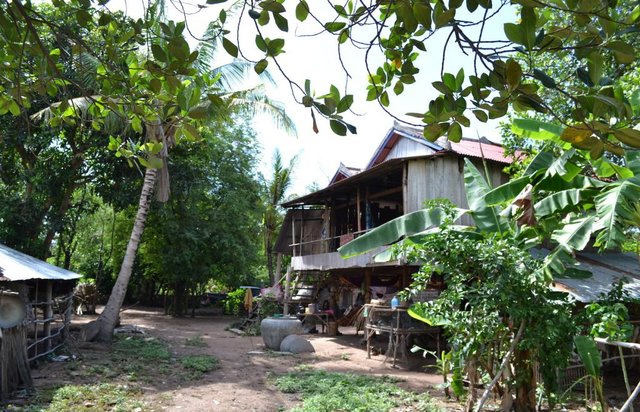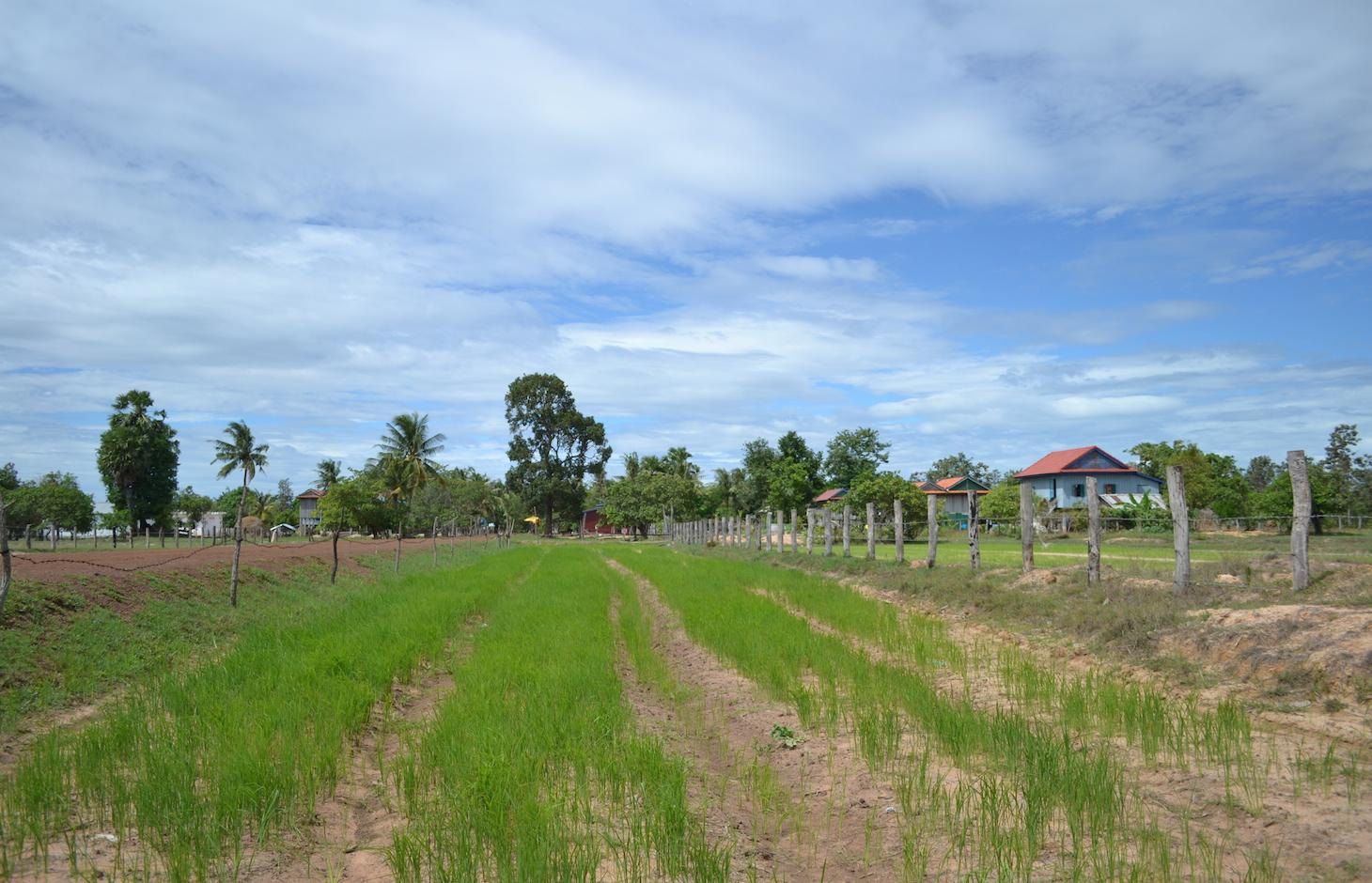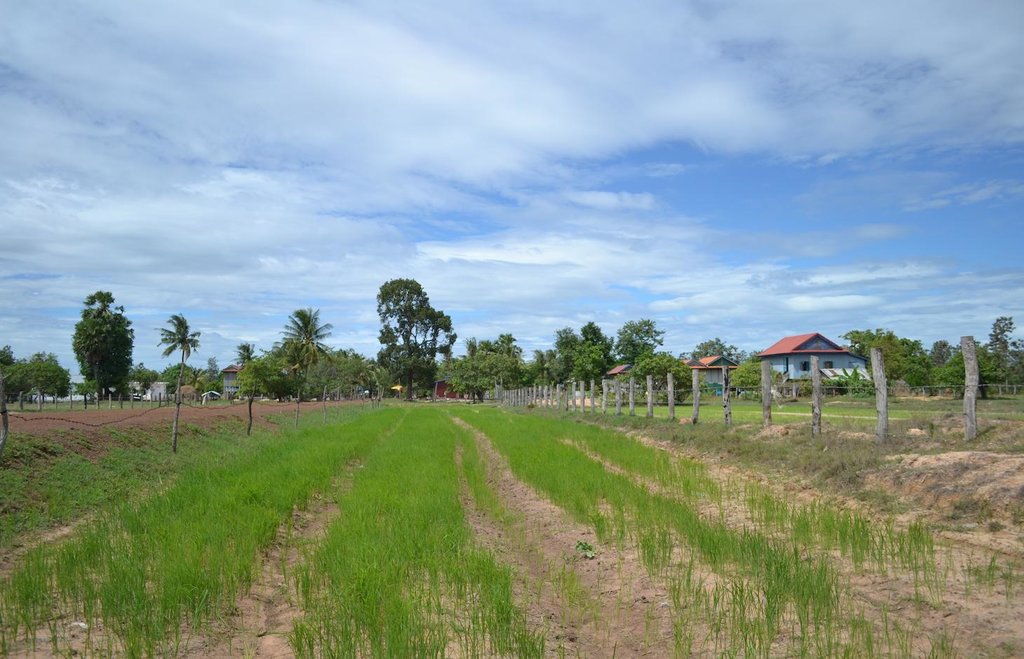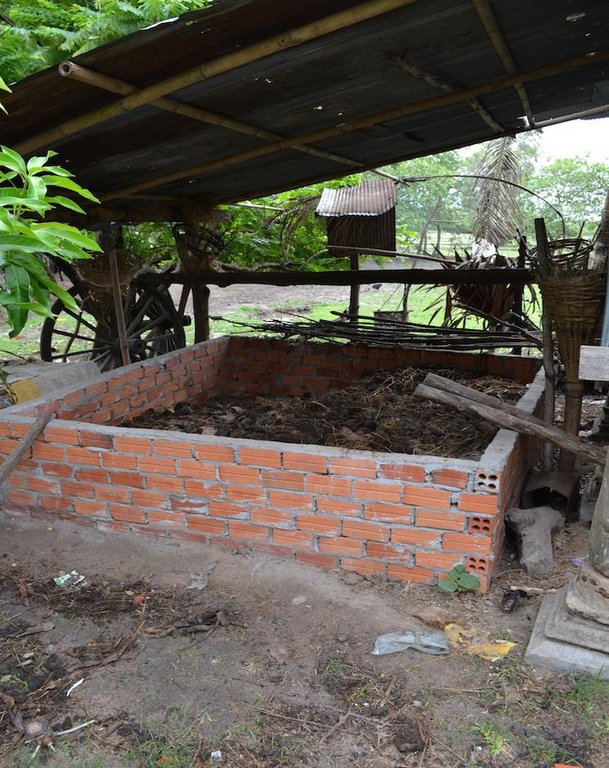Adapted System of Rice Intensification (SRI) principles in Kampong Chhnang [Cambodia]
- Creation:
- Update:
- Compiler: Christoph Kaufmann
- Editor: –
- Reviewers: Deborah Niggli, Alexandra Gavilano
ការទទួលយកប្រពន្ធ័ប្រពលវប្បកម្មដំណំាស្រូវក្នុងខេត្តកំពុងឆ្នំាង (Khmer)
technologies_1224 - Cambodia
View sections
Expand all Collapse all1. General information
1.2 Contact details of resource persons and institutions involved in the assessment and documentation of the Technology
Key resource person(s)
SLM specialist:
SLM specialist:
Khun Lean Hak
SOFDEC/LAREC, www.sofdec.org
SLM specialist:
SLM specialist:
Say Mesa
SOFDEC
Cambodia
SLM specialist:
Bin Sreytouch
SOFDEC
Cambodia
SLM specialist:
Pith Khonhel
LAREC
Cambodia
1.3 Conditions regarding the use of data documented through WOCAT
The compiler and key resource person(s) accept the conditions regarding the use of data documented through WOCAT:
Yes
1.4 Declaration on sustainability of the described Technology
Is the Technology described here problematic with regard to land degradation, so that it cannot be declared a sustainable land management technology?
No
1.5 Reference to Questionnaire(s) on SLM Approaches (documented using WOCAT)

Model farmer [Cambodia]
Model farms were introduced by a NGO in order to spread knowledge about SLM (compost, System of Rice Intensification SRI, and other technologies) in the project area.
- Compiler: Christoph Kaufmann
2. Description of the SLM Technology
2.1 Short description of the Technology
Definition of the Technology:
Some points of the System of Rice Intensification (SRI) technology, like the row transplanting of young seedlings and the use of compost are adapted and applied in Kampong Chhnang.
2.2 Detailed description of the Technology
Description:
The System of Rice Intensification (SRI) was developed in the 1980s in Madagascar, where a French monk worked together with local farmers. The goals of the project were the improvement of the livelihoods of local farmers and the establishment of a farming system that is self-sufficient and thus needs no external inputs. SRI is not a recipe to be followed step by step, but general ideas that need to be adapted to the local conditions. These basic ideas are the following:
- Early transplanting of the seedlings, at the two-leaves-stage (less than 15 days after sowing). At this stage, the plant still has the potential to make a lot of tillers, and develop a strong root system. The seedlings are transplanted carefully, so the plant doesn’t suffer a transplanting shock.
- Wide spacing of single seedlings, usually in squares. The recommended spacing goes from 25 to 50 cm, depending on the soil fertility. This transplanting technique reduces the concurrence between the rice plants and allows the land user easier weeding.
- Aerating the soil. Rice is produced in standing water, but grows better if the roots are aerated. This is usually done with weeding, and additionally either by alternately flooding and letting the soil dry out, or by draining the water regularly. - The soil is fed with compost or manure in order to enhance the fertility and improve the soil structure.
SRI induces changes in deeply rooted local habits with some counter-intuitive knowledge like that more seeds do not produce more yields. Thus the methods have to be adapted locally and yields monitored to fit to other areas.
In Kampong Chhnang, the rice is transplanted at the six-leaves-stage, which is still earlier than conventional transplanting, with spacing of about 15 to 20 cm.
In Kampong Chhnang, the labour availability is low, as many young people work abroad or in the garment industry. Thus the SRI principles, which were taught by an NGO in 2004, were not followed completely, but adapted to this major constraint. The use of very young seedlings requires careful transplanting, which takes time. Thus the seedlings are transplanted at the 6 leaves stage. Due to the low soil fertility in the area, the optimal spacing as tested by CARDI (Cambodian Agricultural Research and Development Institute), was about 20 by 20 cm.
The rice seeds are soaked in water for 24 hours, and then let to germinate in a hot and humid place for two days. Then they are sown on the seed bed, which is prepared with compost. As there is not enough compost available for all the fields, the seedbed is the only place where compost is applied. In the fields chemical fertilizer is used. The seedlings are transplanted after 20 to 25 days (5-6 leaves) single or two per hill, in rows 15 to 20 cm apart. They are transplanted in better levelled fields than conventional transplanting, to allow the use of less water, as the seedlings are smaller than conventional. Otherwise the water management is the same as conventional; due to the lack of labour availability, the fields are not drained as proposed by the NGO 10 years ago. The field is weeded with hoes. The rice is harvested after 85 % of the panicle turned yellow, thus obtaining the best quality.
The analysed area is flat (slope < 2%), with a tropical climate (dry season from November to May and wet season from June to October), and the soils are mostly sandy or loamy. The soil has a low fertility, contains little organic matter, and acidifies. The area has been deforested a long time ago, and the groundwater table is rather high (1-2 m during the dry season, on the surface during wet season).
Due to climate change, farmers notice more erratic rainfalls, temperature rises and more recurrent droughts. Rice is the predominant crop grown in the area, since it serves as staple food (mix subsistence and commercial activities).
The increasing migration rate (the young generation leaves the villages to work in the cities, garment industry or abroad) results in a decrease of available labour force in the area which has detrimental effects on the agricultural activities. Furthermore, the civil war in the 1970s (Khmer Rouge) led to the loss of agricultural knowledge which different NGOs try to re-establish.
2.3 Photos of the Technology
2.5 Country/ region/ locations where the Technology has been applied and which are covered by this assessment
Country:
Cambodia
Region/ State/ Province:
Kampong Chhnang
Further specification of location:
Cher Kroev
Specify the spread of the Technology:
- evenly spread over an area
If precise area is not known, indicate approximate area covered:
- 10-100 km2
2.6 Date of implementation
If precise year is not known, indicate approximate date:
- 10-50 years ago
2.7 Introduction of the Technology
Specify how the Technology was introduced:
- through projects/ external interventions
Comments (type of project, etc.):
In 2004, SRI was introduced to the land user of this case study by SOFDEC. Then the farmers adapted and transformed some steps.
3. Classification of the SLM Technology
3.1 Main purpose(s) of the Technology
- improve production
3.2 Current land use type(s) where the Technology is applied

Cropland
- Annual cropping
- rice
Number of growing seasons per year:
- 1
Specify:
Longest growing period in days: 210, Longest growing period from month to month: June-December
Comments:
Major land use problems (compiler’s opinion): Lack of organic matter, lack of water retention in soil, irregularity of rainfall, low soil fertility (sandy soil), monocultures, bare soil during dry season, ploughing.
Major land use problems (land users’ perception): Low soil fertility, sandy soil with low water retention.
3.4 Water supply
Water supply for the land on which the Technology is applied:
- mixed rainfed-irrigated
3.5 SLM group to which the Technology belongs
- integrated soil fertility management
3.6 SLM measures comprising the Technology

agronomic measures
- A1: Vegetation/ soil cover
- A2: Organic matter/ soil fertility
Comments:
Type of agronomic measures: better crop cover, manure / compost / residues
3.7 Main types of land degradation addressed by the Technology

chemical soil deterioration
- Cn: fertility decline and reduced organic matter content (not caused by erosion)
- Ca: acidification
Comments:
Main causes of degradation: soil management (The soil is ploughed and left bare for weeks in the dry season), crop management (annual, perennial, tree/shrub) (Rice monocultures), over-exploitation of vegetation for domestic use (No organic matter is left on the fields), labour availability (High migration rates.), education, access to knowledge and support services (Khmer Rouge regime led to the loss of agricultural knowledge.)
3.8 Prevention, reduction, or restoration of land degradation
Specify the goal of the Technology with regard to land degradation:
- prevent land degradation
- reduce land degradation
4. Technical specifications, implementation activities, inputs, and costs
4.1 Technical drawing of the Technology
Technical specifications (related to technical drawing):
Cambodia
Date: 25.10.2011
Technical knowledge required for field staff / advisors: high
Technical knowledge required for land users: moderate
Main technical functions: increase in nutrient availability (supply, recycling,…)
Secondary technical functions: increase in organic matter
Better crop cover
Material/ species: Rice
Remarks: Single or 2 young rice seedlings per hill, in rows, space 15-20 cm
Manure / compost / residues
Material/ species: 2 – 3 t of compost for the seed bed (0.25 ha, transplanted on 1 ha), 75 kg/ha after transplanting.
Quantity/ density: 2-3 t
Author:
Luy Pisey Rith, Oxfam America, #94, Russian Boulevard, Sangkat Teuk Laak I, Khan Toul Kork, Phnom Penh, Cambodia
4.2 General information regarding the calculation of inputs and costs
Indicate average wage cost of hired labour per day:
4.50
4.4 Costs and inputs needed for establishment
| Specify input | Unit | Quantity | Costs per Unit | Total costs per input | % of costs borne by land users | |
|---|---|---|---|---|---|---|
| Equipment | Compost house | 1.0 | 15.0 | 15.0 | 33.0 | |
| Total costs for establishment of the Technology | 15.0 | |||||
| Total costs for establishment of the Technology in USD | 15.0 | |||||
4.5 Maintenance/ recurrent activities
| Activity | Timing/ frequency | |
|---|---|---|
| 1. | Ploughing the seed bed (either part of the paddy fields or different field) | 1 / year |
| 2. | Put seeds 24 hours in water | 1 / year |
| 3. | Cover the seeds in a warm place for incubation until they sprout (approximately 2 days, temperatures between 37-40 °C), plant the seedlings in seed bed and let them grow for about 20 - 25 days | 1 / year |
| 4. | Ploughing of rice paddy field | 2 / year |
| 5. | Pull the seedling from seed bed, row transplanting of young rice seedlings (20-25 days): 1-2 seedlings per hill, not too deep into the soil, in 1-2 cm of water. | 1 / year |
| 6. | Add chemical fertilizer to the paddy fields (20 days after transplanting) | 1 / year |
| 7. | Weed control (easier because of row transplanting), done manually | 2 / year |
| 8. | Harvest rice manually when plant is 85% mature. | 1 / year |
4.6 Costs and inputs needed for maintenance/ recurrent activities (per year)
| Specify input | Unit | Quantity | Costs per Unit | Total costs per input | % of costs borne by land users | |
|---|---|---|---|---|---|---|
| Labour | labour | ha | 1.0 | 228.0 | 228.0 | 100.0 |
| Equipment | animal traction | ha | 1.0 | 56.0 | 56.0 | 100.0 |
| Plant material | seeds | ha | 1.0 | 15.0 | 15.0 | 100.0 |
| Fertilizers and biocides | fertilizer | ha | 1.0 | 55.0 | 55.0 | 100.0 |
| Fertilizers and biocides | compost/manure | ha | 1.0 | 10.0 | 10.0 | 100.0 |
| Total costs for maintenance of the Technology | 364.0 | |||||
| Total costs for maintenance of the Technology in USD | 364.0 | |||||
Comments:
Machinery/ tools: Plough; a hand weeder can be used for higher yields but not enough labour is available on the fields. 1 ha; farmer owns 2 ha; year 2014
4.7 Most important factors affecting the costs
Describe the most determinate factors affecting the costs:
The factor affecting the costs the most is the labour. SRI is labour intensive; the farmer needs twice as much time for a SRI field than for a conventional field. This is the reason he makes only a few of the steps he was taught 10 years ago by SOFDEC.
5. Natural and human environment
5.1 Climate
Annual rainfall
- < 250 mm
- 251-500 mm
- 501-750 mm
- 751-1,000 mm
- 1,001-1,500 mm
- 1,501-2,000 mm
- 2,001-3,000 mm
- 3,001-4,000 mm
- > 4,000 mm
Specifications/ comments on rainfall:
1486.45 mm 2013 in Kampong Chhnang
Agro-climatic zone
- sub-humid
Thermal climate class: tropics. 27-35°C
5.2 Topography
Slopes on average:
- flat (0-2%)
- gentle (3-5%)
- moderate (6-10%)
- rolling (11-15%)
- hilly (16-30%)
- steep (31-60%)
- very steep (>60%)
Landforms:
- plateau/plains
- ridges
- mountain slopes
- hill slopes
- footslopes
- valley floors
Altitudinal zone:
- 0-100 m a.s.l.
- 101-500 m a.s.l.
- 501-1,000 m a.s.l.
- 1,001-1,500 m a.s.l.
- 1,501-2,000 m a.s.l.
- 2,001-2,500 m a.s.l.
- 2,501-3,000 m a.s.l.
- 3,001-4,000 m a.s.l.
- > 4,000 m a.s.l.
5.3 Soils
Soil depth on average:
- very shallow (0-20 cm)
- shallow (21-50 cm)
- moderately deep (51-80 cm)
- deep (81-120 cm)
- very deep (> 120 cm)
Soil texture (topsoil):
- coarse/ light (sandy)
- medium (loamy, silty)
Topsoil organic matter:
- medium (1-3%)
- low (<1%)
5.4 Water availability and quality
Ground water table:
< 5 m
Availability of surface water:
poor/ none
Water quality (untreated):
poor drinking water (treatment required)
Comments and further specifications on water quality and quantity:
Ground water table: during dry season
Availability of surface water: during dry season
5.5 Biodiversity
Species diversity:
- low
5.6 Characteristics of land users applying the Technology
Market orientation of production system:
- mixed (subsistence/ commercial)
Off-farm income:
- 10-50% of all income
Relative level of wealth:
- poor
- average
Individuals or groups:
- individual/ household
Level of mechanization:
- manual work
- animal traction
Gender:
- women
- men
Indicate other relevant characteristics of the land users:
Land users applying the Technology are mainly common / average land users
Population density: 10-50 persons/km2
Annual population growth: 0.5% - 1%
Off-farm income specification: Handicrafts, factory work, remittances
5.7 Average area of land used by land users applying the Technology
- < 0.5 ha
- 0.5-1 ha
- 1-2 ha
- 2-5 ha
- 5-15 ha
- 15-50 ha
- 50-100 ha
- 100-500 ha
- 500-1,000 ha
- 1,000-10,000 ha
- > 10,000 ha
Is this considered small-, medium- or large-scale (referring to local context)?
- small-scale
5.8 Land ownership, land use rights, and water use rights
Land ownership:
- communal/ village
- individual, not titled
Land use rights:
- communal (organized)
- individual
Water use rights:
- open access (unorganized)
Comments:
Land users have a title that is not recognized by the state
5.9 Access to services and infrastructure
health:
- poor
- moderate
- good
education:
- poor
- moderate
- good
technical assistance:
- poor
- moderate
- good
employment (e.g. off-farm):
- poor
- moderate
- good
markets:
- poor
- moderate
- good
energy:
- poor
- moderate
- good
roads and transport:
- poor
- moderate
- good
drinking water and sanitation:
- poor
- moderate
- good
financial services:
- poor
- moderate
- good
6. Impacts and concluding statements
6.1 On-site impacts the Technology has shown
Socio-economic impacts
Production
crop production
Comments/ specify:
Around 20% more yields
risk of production failure
Comments/ specify:
Seedbed can be irrigated
Water availability and quality
demand for irrigation water
Comments/ specify:
The seedbed is smaller, so less irrigation is needed in the beginning of the rainy season/dry spell
Income and costs
expenses on agricultural inputs
Comments/ specify:
Used half the amount of seeds
farm income
workload
Socio-cultural impacts
food security/ self-sufficiency
Comments/ specify:
Crop is more tolerant to droughts. He uses less chemical fertilizer since he uses compost
SLM/ land degradation knowledge
Comments/ specify:
Knowledge about composting
conflict mitigation
contribution to human well-being
Comments/ specify:
SRI increased the rice yields and reduces the use of seeds.
Ecological impacts
Soil
soil organic matter/ below ground C
Comments/ specify:
Compost only used in seedbed
6.3 Exposure and sensitivity of the Technology to gradual climate change and climate-related extremes/ disasters (as perceived by land users)
Gradual climate change
Gradual climate change
| Season | increase or decrease | How does the Technology cope with it? | |
|---|---|---|---|
| annual temperature | increase | not known |
Climate-related extremes (disasters)
Meteorological disasters
| How does the Technology cope with it? | |
|---|---|
| local rainstorm | well |
| local windstorm | not known |
Climatological disasters
| How does the Technology cope with it? | |
|---|---|
| drought | well |
Hydrological disasters
| How does the Technology cope with it? | |
|---|---|
| general (river) flood | not well |
Other climate-related consequences
Other climate-related consequences
| How does the Technology cope with it? | |
|---|---|
| reduced growing period | not known |
6.4 Cost-benefit analysis
How do the benefits compare with the establishment costs (from land users’ perspective)?
Short-term returns:
positive
Long-term returns:
very positive
How do the benefits compare with the maintenance/ recurrent costs (from land users' perspective)?
Short-term returns:
positive
Long-term returns:
very positive
Comments:
The building of the compost house (only establishment cost) was subsidized, so he had to pay only 5 $ to build it. On the long term the addition of compost is very positive for the soil fertility.
6.5 Adoption of the Technology
Of all those who have adopted the Technology, how many did so spontaneously, i.e. without receiving any material incentives/ payments?
- 11-50%
Comments:
67% of land user families have adopted the Technology with external material support
33% of land user families have adopted the Technology without any external material support
20 land user families have adopted the Technology with external material support
10 land user families have adopted the Technology without any external material support
Due to the lack of labour force less farmers are applying the SRI technology.
6.7 Strengths/ advantages/ opportunities of the Technology
| Strengths/ advantages/ opportunities in the land user’s view |
|---|
| Improved soil structure and fertility due to the compost addition. |
| Strengths/ advantages/ opportunities in the compiler’s or other key resource person’s view |
|---|
| Improved yields (ca. 20%) |
| Better price possible if he applied SRI without chemical fertilizer and if he sold the yield on the organic market. |
6.8 Weaknesses/ disadvantages/ risks of the Technology and ways of overcoming them
| Weaknesses/ disadvantages/ risks in the land user’s view | How can they be overcome? |
|---|---|
| The seedlings have to be treated with care. | More yields, less dependent on off-farm income. |
| Increases the workload. | Change the local agriculture to more perennials and animals to produce more organic matter (shift toward integrated farming). |
| SRI needs more compost than is available. |
| Weaknesses/ disadvantages/ risks in the compiler’s or other key resource person’s view | How can they be overcome? |
|---|---|
| The fields are always flooded, thus there are anaerobic conditions in the root area. | Either, the water can be drained before the rain, or the fields can alternatively be dried out and flooded. |
| The seedlings are much older at the 6 leaves stage than recommended by SRI. | Experiment with transplanting of younger seedlings. |
7. References and links
7.1 Methods/ sources of information
- field visits, field surveys
- interviews with land users
When were the data compiled (in the field)?
03/07/2014
7.2 References to available publications
Title, author, year, ISBN:
List of documentation about SRI in English
Available from where? Costs?
http://sri.ciifad.cornell.edu/extmats/index.html#english (free)
Links and modules
Expand all Collapse allLinks

Model farmer [Cambodia]
Model farms were introduced by a NGO in order to spread knowledge about SLM (compost, System of Rice Intensification SRI, and other technologies) in the project area.
- Compiler: Christoph Kaufmann
Modules
No modules




